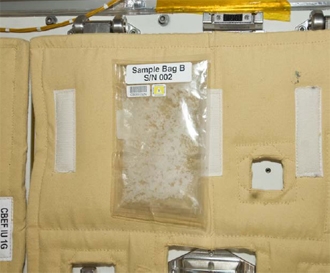This is an archive of information released in the past.
Disclaimer: It may contain broken links or outdated information. Some parts may not function in current web browsers.
*Visit https://humans-in-space.jaxa.jp/en/ for the latest information.

Experiment
- News
- Kibo Utilization Strategy
- Kibo Utilization Plan
- List of JAXA's Utilization Themes
- Experiment Facilities
- Space Environment Utilization
- Archive
Nanoskeleton Experiment Completed
* All times are Japan Standard Time (JST)
Production of High Performance Nanomaterials in Microgravity (Nanoskeleton), which uses the Cell Biology Experiment Facility (CBEF) in Kibo, was completed. When the samples are returned to the ground, the Nanoskeleton team will perform sample analysis to evaluate effects of gravity, and will determine the optimal condition for production of a high performance Nanoskeleton material.
The Nanoskeleton experiment was completed at 4:54 p.m. on March 12, 2010.
Nanoskelton is a new category of material that has improved properties of porous material, which can be used for development of photocatalyst. The project tries to create new nanoskeleton materials, which the size of the pore (the part of the pipe-shaped hole) of the tube are widened, in the microgravity condition characterized by absence of gravity-induced convection, surfacing, and sedimentation.
The experiment was conducted according to the following timeline.
- February 8: Samples were launched aboard Endeavour (STS-130 Mission)
- March 1: Astronaut Noguchi prepared the samples
- March 2: Astronaut Noguchi mixed and stirred the samples and began the experiment at about 8:25 p.m.
- Data and video images were downlinked during the experiment
- March 5 and March 12: Reactions of the samples were discontinued / experiment was completed
- The samples were returned to the ground aboard Discovery on the STS-131 Mission, on which Astronaut Yamazaki flew.
After the samples are returned to the project team, the team will compare the control samples produced on the ground and the space-grown samples. Gravity influence during the production process will be clarified in detail. The experiment result will be processed in the computer simulation, to understand an optimal condition for production of high quality Nanoskeleton materials.The project aims at making contribution to development of photocatalyst-based products, which would solve environmental issues and energy issues on Earth.

Sample of the 3-day Nanoskeleton experiment;
the sample was collected on March 5, 2010
Whitish portions are Nanoskeleton samples produced in space
*All times are Japan Standard Time (JST)
| Copyright 2007 Japan Aerospace Exploration Agency | Site Policy |